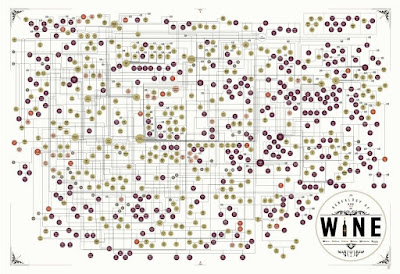Monday, December 3, 2018
The pedigree of grape varieties
We are all familiar with the concept of a family tree (formally called a pedigree). People have been compiling them for at least a thousand years, as the first known illustration is from c.1000 CE (see the post on The first royal pedigree). However, these are not really tree-like, in spite of their name, unless we exclude most of the ancestors from the diagram. After all, family histories consist of males and females inter-breeding in a network of relationships, and this cannot be represented as a simple tree-like diagram without leaving out most of the people. I have written blog posts about quite a few famous people who have really quite complex and non-tree-like family histories (including Cleopatra, Tutankhamun, Charles II of Spain, Charles Darwin, Henri Toulouse-Lautrec, and Albert Einstein).
Clearly, the history of domesticated organisms is even more complex than that of humans. After all, in most cases we have gone to a great deal of trouble to make these histories complex, by deliberately cross-breeding current varieties (of plants) and breeds (of animals) to make new ones. So, I have previously raised the question: Are phylogenetic trees useful for domesticated organisms? The answer is the same: no, unless you leave out most of the ancestry.
In most cases, we have no recorded history for domesticated organisms, because most of the breeding and propagating was undocumented. Until recently, it was effectively impossible to reconstruct the pedigrees. This has changed with modern access to genetic information; and there is now quite a cottage industry within biology, trying to work out how we got our current varieties of cats, dogs, cows and horses, as well as wheat, rye and grapes, etc. I have previously looked at some of these histories, including Complex hybridizations in wheat, and Complex hybridizations in barley and its relatives.
Grapes
One example of particular interest has been grape varieties. I have discussed some of the issues in a previous post: Grape genealogies are networks, not trees, including the effects of unsampled ancestors when trying to perform the reconstruction.
There are a number of places around the web where you can see heavily edited summaries of what is currently known about the grape pedigree. However, these simplifications defeat the purpose of this blog post, which is to emphasize the historical complexity. The only diagram that I know of that shows you the full network (as currently known) is one provided by Pop Chart (The Genealogy of Wine), a commercial group who provide infographic posters for just about anything. They will sell you a full-sized poster of the pedigree (3' by 2'), but here I have provided a simple overview (which you can click on to see somewhat larger).
You can actually zoom in on the diagram on the Pop Chart web page to see all of the details. This allows you to spend a few happy hours finding your favorite varieties, and to see how they are related. You will presumably get lost among the maze of lines, as I did.
Labels:
Genealogy,
Hybridization network,
Pedigree
Subscribe to:
Post Comments (Atom)



As far as I can tell, no grapes from Georgia are represented on this chart, although Georgia supposedly has more grape genetic diversity than the rest of the world put together.
ReplyDeleteIndeed, Georgia has that reputation. The issue for the genealogy is that they are ancient varieties, so that working out the parents is incredibly difficult, even if any of the current varieties are actually the parents (rather than the parents now being extinct).
ReplyDelete